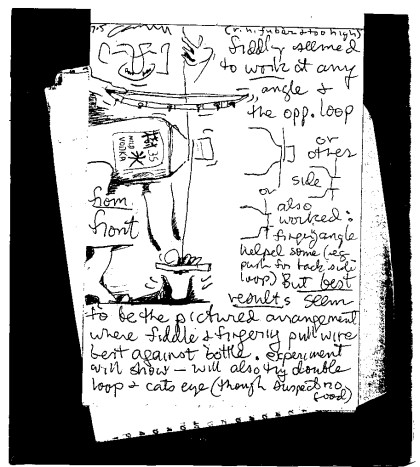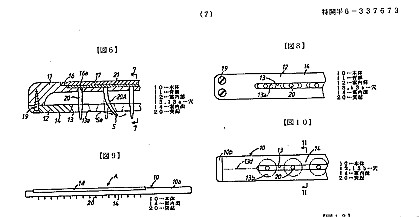the
one-string experiment
For decades the discrepancy between my natural ability to copy fine folk trills and improvise harmony with my inability to improve my guitar skills puzzled and frustrated me. Guitar players far better than me seemed impressed by my note-bending ( the simplest thing in the world to me!) and that suggested to me that there may be two different musical talents, the ability to play by feel (which i apparently had) and the ability to simultaneously do complex things with the fingers on each hand, which i clearly did not have. As i also wanted to have an instrument to accompany my songs, in 1993, i decided to test my hypothesis.
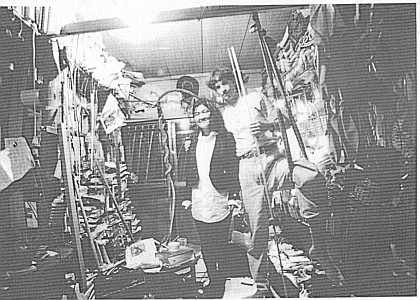
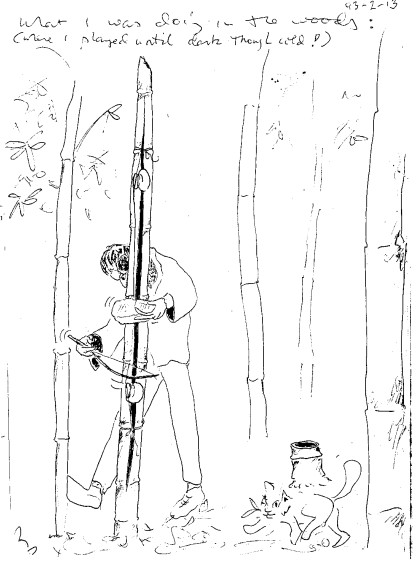
My second hypothesis was that the different talents were of the nature of building up (as one does when drawing on a blank sheet) versus sculpting down. What if I could not pluck notes out of the silence but had the ability to shape the constant noise of a moving bow? So, I had two things to test. I began by making a one-fiddle and a bow.
But, as you can see by the above photo, my bedroom/livingroom/study/ workshop was tiny. (The other person is Micki, an artist friend of my sister at OSU who visited me while visiting her grandmother in Japan. As a skilled pianist, I doubt that she could fully appreciate my desperation with complex instruments, but she kindly suffered through a sampling of some of my earliest one-string sounds!*).
So, I did some of my experimenting outside. I had already played the bamboo like xylophones where the different-sized sections created different notes. My favorite music was an imitation of a local denizen, the bell-cicada. here the bottle in my left hand used for "fingering" and the pudding cup under the string are both vibrating, so I am hearing myself fiddle in stereo. My cat has other things on his mind.
*Micki, send your memories and i'll put them here
MOVING SOUND-BOX
I am not at all bald and do not have a sharp nose, but otherwise the drawing is precise. Though the main soundbox is in my left hand, the distance between it and the edge of the door is what counts. I fail to show that my right foot could push on the door and effect the tension of the string.
There is no reason the sound box must be attached to the string. That is one of the fundamental discoveries I made very early on in the experiment. Such discoveries led to many potential products, but being close to penniless, I was without means to patent and produce them. In short, my most productive years were very sad, for I had found a sort of musical heaven but did not have the means to enter. An acoustical engineer who was impressed with the loud sound I got from a tiny plastic bottle (mainly thanks to the heavy vice grounding the piano wire, but still interesting for most acoustical engineers are taught that plastics have poor acoustical properties when reality is much more complex.) sent a reporter who heard and reported on my "hinge-fiddle" where the single string's tension was varied by the angle of my left leg to which a hinged stick was tied. Unfortunately, the principles of my experiment were hardly touched upon in the article which expanded on the headline theme, namely that I was turning junk=PET (polyethylene?) bottles into instruments. (I'll insert a photo of the article, later, it is not at hand)
I think the ear-phone is only my winter ear-muffs, for i used no heating though my inner ears have poor blood circulation due to a neck injury. Another time, I strung the piano wire over a beam and passed it over my ears and, as a matter of fact, it did serve as an earphone!
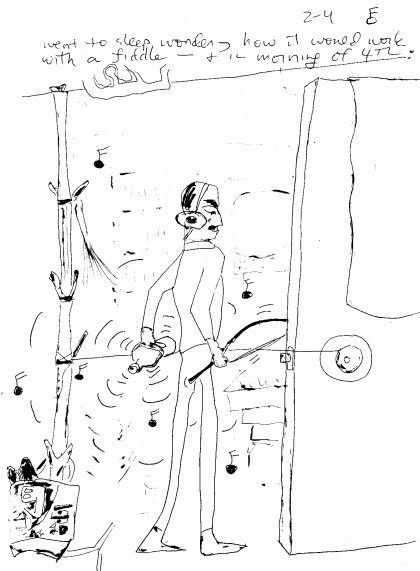
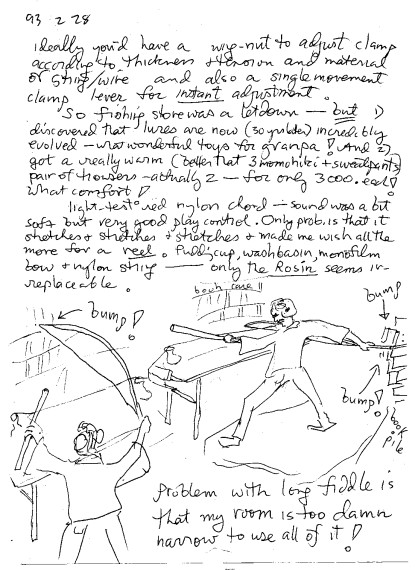
CRAMPED QUARTERS
Once I found out that monofilm (what we once called the clear stuff now considered standard fishing line) could work for horse hair- I tried many types of bows (Note, however: at first you must use some solvent to melt the rosin to get it to stick (perhaps all those things they do to stop it from catching on the surface of the water get in the way) or you will be very disappointed with your silent fiddle.)
I quickly abandoned the rounded bow for a straight stick and in one version used piano wires behind the bow to control its tension. A long bow had its advantages and was not tiring for horizontal fiddling. The only problem was that my room was so small it whacked against the book stacks on both sides. Beside the long continuous bowing permitted by the long playing surface, a long butt (or medium one with a weight) kept the front of the bow light on the string).
Poverty -- When your fiddlestick hits both sides of the room -- rdg
I also found that the best high notes could be obtained by a bare fiddlestick! I used a rosined pipe. Various sticks were also conducive to various types of skipping, which sound great. Later, I was to harden up and go small, but in the early stages of my experiments the banquet table fiddle served me admirably. I left it up at night and barely had room to sleep beside it.
THE FROTTAGE FIDDLE
What fun I had with this bow made for playing against things! One cannot help but walk around playing against anything, telephone poles, trees, lamp posts . . . The only problem was that the rails pictured here were painted so that they squeaked a bit on the string/wire. The sound box is a PET bottle. If it were attached to a piece of heavy metal or would the vibration would leak less and the noise grow proportionately. A stiffer and straighter bow would be more controllable, but I could only use what I had on hand, i.e., a skinny bamboo-like cane found in the woods nearby.
At this time, I began to imagine a number of people playing together. A jam session of one strings. Multi-person chords. Choreographed in festivals, perhaps on a stage, though you couldn't drag me to a theater.
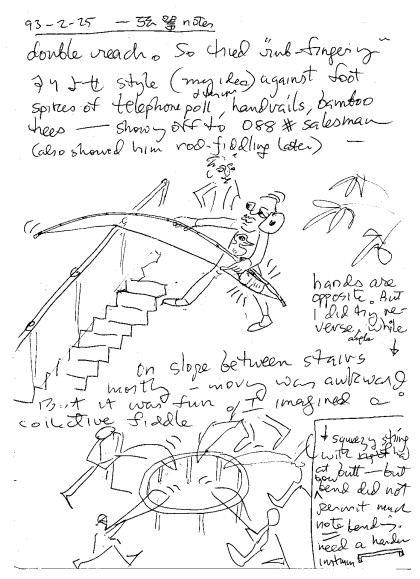
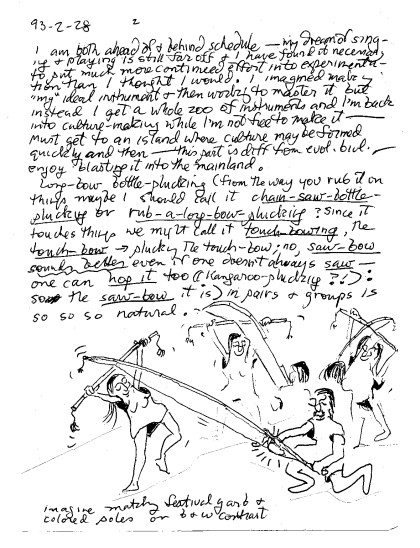
I have seen two people play a single banjo in a novelty session at a bluegrass festival, but this need not be special "freak" performance. It could be another form of making music, akin to dancing, where it only made sense together.
Obviously, two-people playing one instrument would be easiest if the participants did it together with music they already knew. (Some folk traditions have such percussion playing). I imagine a festival.
Note that either person is free to move. They could take turns with the melody, though only one can pick.
PLAYING LIKE A GATOR
True, this is a totally worthless instrument made after finding a badminton racket in the trash. I'll substitute a better picture later! All my later experiments and best drawings are not with me at the moment.
But there is something to note here. I am not fiddling with a bow but with teeth on a stick. Hence the alligator. (My cat, like Koko the gorilla, was terrified by the alligator who served to guard my computer keyboard.
The "pickstick" was invented earlier in the month.
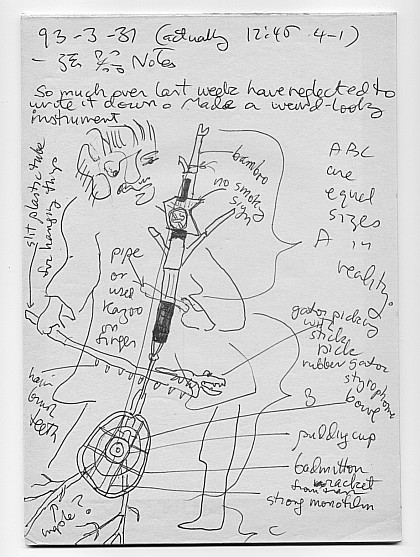
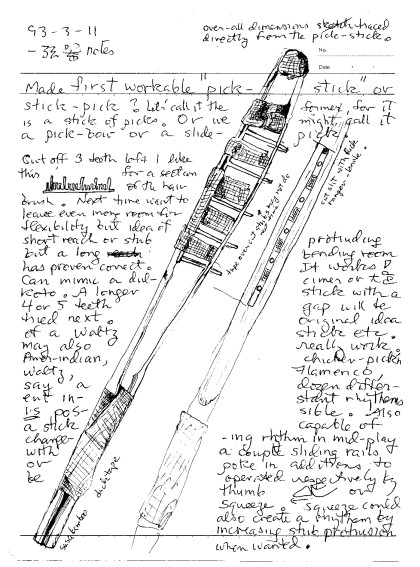
This was my first model of the "pickstick," a device that allowed crisp staccato notes to be rapidly picked. The next model was about three feet long and had dozens of teeth (hairbrush teeth).
The secret/invention was a slit. By fixing the back of each tooth/pick to a backing and passing it through a slitted surface (a sort of runner or rails, if you wish) to keep the string from getting caught in the crotch of the tooth and allowing room for said tooth to bend completely flush with the surface, the tooth could simultaneously address the string at a right angle (providing crisp sound) and move as smoothly as a bow, without getting hung up.
At the time I devised this, I did not know about the sticks used to play the tuba marina (a base-like one-string instrument), but they did not make a crisp-sound for the teeth resemble sharp waves and are not perpendicular. Without the slit, no true multiple picking device is possible.
I applied for a patent with the advice of a patent attorney in Japan, for it was very inexpensive. Seven years later, the limit for an application for an exam came and I had to give up any hope of patenting, for I did not have the money to spare. Poverty, again. While my main interests in music led elsewhere, the principle is solid and would apply to rotary picks as well.
Since then, i have made more important inventions, mostly for the fingering hand, and intended for use with invented instruments; but lack of time or money have prevented patenting. Errrgh!
METAPHORICAL EXCITEMENT
The experiment got me intrigued about so many things. I had instruments so light it made as much sense to move them as to move my left hand, so i ended up moving both.
Usually, we move our hands close in to us to play a high note on a string instrument. If the instrument is held head up (as is true for the cello or the Chinese fiddle) this means that the hand is moved down with respect to the earth to raise a note. But if the instrument was moved instead,
Ah! What metaphorical joy!
Yes the direction of the movement and the variation in the sound was, for once, the same.
I pretty much ruined the pictures in these early notebooks by using a pink pen for the flesh. Later I learned NEVER to color one's notebook, for one can always make B&W copies and make better pictures with more subtle pastel.
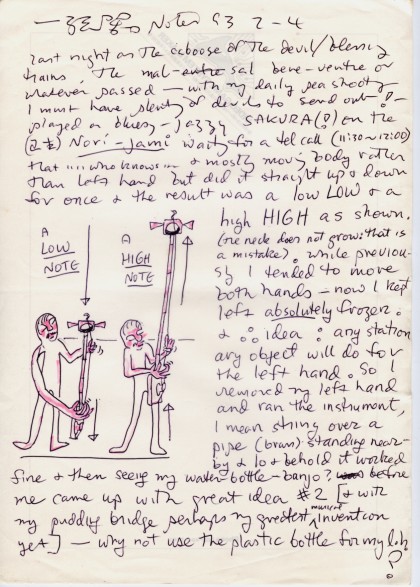
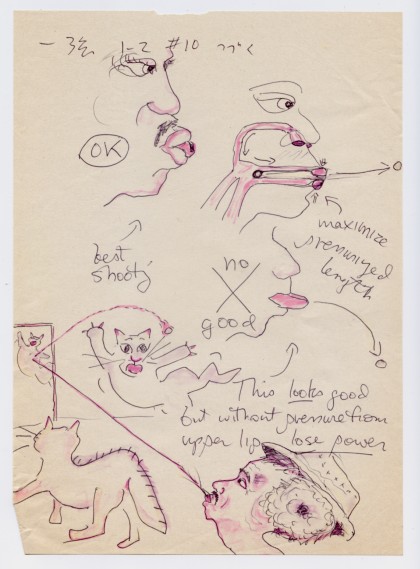
The unbroken string of experiments did something to my brain, I found myself doing new things, almost daily.
For example, I washed vegetables using my shower. Or, what you see in this illustration: I learned to use my tongue as a pea-shooter. I always kept a plentiful supply of soy beans on hand and a few pea-shooters to keep my cats in line, protect them from a roving Tom, and to shoot at the soap bubbles I liked to blow into the bamboo woods, for the sport of it. But, despite having curled my tongue since grade-school, I never thought of using it as a pea-shooter. I found I could shoot beans with great force around the room! Since the cat did not oblige me with misconduct at the time of my sudden realization, I aimed at its reflection in the mirror, which could hardly be jumping already as pictured.
Within a couple more months, as my instruments and i improved together, i learned that even if i could fiddle any tune i wanted to, i could not fiddle and sing at the same time. On the other hand, i discovered something else for the first time in my life. If you really can play, who needs to sing! What happened? Improvisation. I had so much fun playing with Okinawan and blues and Mexican and Spanish and Indian (India Indian) music coming over my 400 channel cable radio that I once burned a pot of food, filled the pot with water and turned it on low flame to try to clean the previous burn and burnt it all over again! That's right. I completely lost track of time. Weaving all different melodies (often with the theme of the vocals my excuse) into songs, taking care to hit the base notes just enough to keep them "in key" and splicing together ethnic music (fast flamenco + slow Japanese, Okinawan + lullaby, Indian and English ballad, etc.), i lost all interest in singing! -- (more another time)
